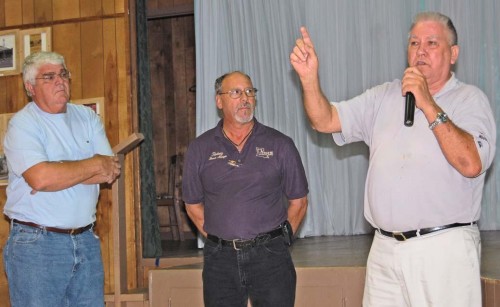Aug. 11
August 11, 2009Ruth Hills Blunt
August 13, 2009Though the Louisiana Supreme Court ruled that Arlen “Benny” Cenac Jr. could restrict access to the Barataria and Lafourche Company Canal near Gheens, residents still contend that the waterway is owned by the state.
Gheens residents argue that the canal, in use since the 1800s, should be considered public. Many residents used the canal, dug between Morgan City and New Orleans in the 1830s by slaves, to reach their fishing camps in Lake Salvador.
In 2002, the community took Cenac, a wealthy landowner and towboat fleet owner, to court over the title to the land. He bought Golden Range Plantation from the Kentucky-based Gheens Foundation in 1998 and 2004, according to the Foundation’s records.
The residents contend that Cenac owns Golden Ranch Plantation and not the canal. The canal runs through the plantation.
The Louisiana Supreme Court awarded Cenac the title to the canal in 2003. He closed it for public use in October 2007.
According to the Arizona Daily Star, which ran an article about Louisiana landowners closing waterways to the public, the Louisiana Supreme Court ruled that Cenac owned the land surrounding the canal and has the right to restrict access to it.
Since then, the Gheens residents have continued to fight against the ruling. The Lafourche Parish Council requested that the Louisiana Attorney General’s Office examine the canal’s title.
“That canal means everything to the Gheens community,” said Councilman Lindel Toups. “Everyone had their camps back there on Lake Salvador. When Cenac closed the bridge it forced any resident from this area who wanted to go fishing to have to travel to either Lockport or Des Allemands to access navigable waters.”
Before, residents could travel nearly eight miles up the canal to reach Lake Salvador.
J. Bradley Oubre, a retired real estate expert who is helping research information on the title, said the Attorney General’s office’s inability to get the information stems from a lack of funds.
“To help them with some research, we gathered this information to help the Attorney General’s Office to initiate an effort to regain state ownership and public access to the canal,” Oubre said
In addition to Oubre, Andy LeBouef and former state Sen. Michael Robichaux are helping to uncover information on whether the state still owns the title to the Barataria and Lafourche Company Canal.
“It stinks,” Oubre said at a Vacherie Gheens Community Center gathering. “This situation is as curvy as the River Road.”
According to Oubre, there are many flaws in the land transactions for the canal that date back to the 1800s when the land was originally donated. Oubre said none of the information was revealed in the Gheens residents’ trial versus Cenac.
While researching the land transactions for the canal, Oubre found the original land donation papers where former Louisiana Governor Pierre Charles Derbigny and Noel Le Breton prohibited a sale of the property as part of the donation.
Derbigny and Le Breton donated 300 feet of land along the Vacherie ridge east of Bayou Lafourche in 1833 for the construction of the canal, according to a book written by Thomas Becnel that traces the canal to the Barrow Family in Houma.
A second flaw came when Oubre examined the Lafourche Parish assessor’s tax roll from the 1800s that was archived in Baton Rouge. The copy of the roll failed to reflect any property listed in the name of Barataria and Lafourche Canal Company until 1871. Twenty-four lots were listed.
Then the roll listed 24 lots in 1872 and 54 lots in 1873, but nothing else, Oubre said.
“Act 47 of 1873 requires, prior to a tax sale, that property must be listed on the tax rolls in the owner’s name,” he said. ” The listed owner must be given written notice with a description of the property to be sold. If the owner fails to pay the taxes due, the assessor must advertise the property in the local newspaper three times within 30 days and auction it off to the highest bidder.”
“After the tax sale is consummated,” Oubre added, “the tax collector must issue an oath describing the property that was sold, a tableau showing the distribution of the proceeds and record the results in public conveyance records of the parish.”
In this case, an ad was placed in the Thibodaux Sentinel newspaper describing 54 lots. A copy of the paper was archived.
“The newspaper ad states the sale is being conducted in accordance with the 1873 law,” he said. “The obvious conflict indicates that the assessor was a party to whatever scheme was being undertaken. The tax collector prepared the tax rolls, authorized the ad in the paper and with full knowledge conducted an illegal sale.”
“A title to state property obtained by fraud leaves a lot to be desired,” Oubre added. “The law is clear and one cannot prescribe against the sovereign and there is no prescriptive period for any fraudulent act.”
Oubre said sugar planter Robert Ruffin Barrow satisfied the debt of the Barataria and Lafourche Company Canal under the name Barataria and Lafourche Company Canal No. 2.
Barrow agreed to pay the debt in return for gaining possession of all the slaves and equipment the state held in stock. Oubre said the debt was owed to the Consolidated Association of Farmers of Louisiana. Barrow paid the debt and equipment and slaves were tendered to him.
However, Oubre said the note should have been canceled. Instead R.R. Barrow instituted a foreclosure action against the Barataria and Lafourche Canal Company in 1862.
“Mr. Barrow and his legal team designed a maneuver that has gone undetected for over 140 years,” Oubre said. “In 1862, Barrow maintains he filed a foreclosure suit against B&L claiming the debt instrument represented a debt owed to him by the state agency.”
“A portion of the property donated by Mr. Derbigny and Mr. Le Breton prohibited a sale of any part or the whole of the land. Property that cannot be sold cannot be mortgaged. The foreclosure instituted by Barataria and Lafourche Canal Company No. 2 lacked legal standing. There was no debt. Barataria and Lafourche Canal Company did not owe any money to B&L No. 2 or Barrow.”
The real legal mishap, Oubre said, was that there is no evidence to support the foreclosure claim. There was a docket number in the records of the Fifth District Court of New Orleans but no record of it anywhere else.
Oubre said the records were allegedly transferred to Jefferson Parish. Officials in Jefferson claim that they never received the record.
Also, Oubre said Barataria and Lafourche Land Company No. 2 never registered with the Secretary of State’s office as required by law.
The group is planning to take the information to the Attorney General’s office hoping that something can be done to restore the canal back to the community.
“I have been working on this for two years,” Oubre said. “There have been stories about this but no one had any real proof. We’ve got some now.
“Hopefully the attorney general will take what we have and make a ruling that will bring justification to a right that was wronged many years ago,” he added.
Lafourche Parish Councilman Lindel Toups (at far right) addresses members of the Gheens community at a recent meeting outlining ownership of the area. Real estate expert J. Bradley Oubre contends the Barataria and Lafourche Company Canal is owned by the state. Also pictured are councilmen Daniel Lorraine (at left) and Rodney Doucet. * Photo by SOPHIA RUFFIN











